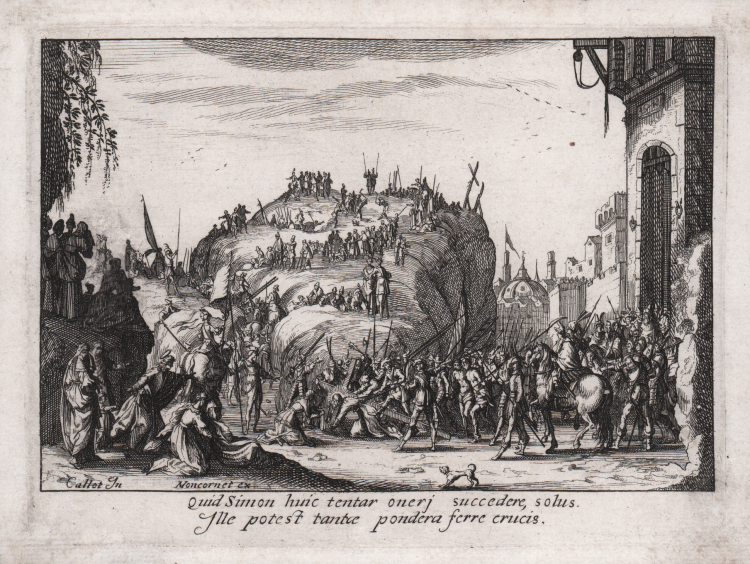




| Reference: | S47135 |
| Author | Charles Nicolas COCHIN |
| Year: | 1650 ca. |
| Measures: | 140 x 105 mm |



| Reference: | S47135 |
| Author | Charles Nicolas COCHIN |
| Year: | 1650 ca. |
| Measures: | 140 x 105 mm |
Jesus falls under the weight of the cross on the way to Calvary. A large crowd of soldiers and passersby witnesses the scene. In the background: Golgotha with crosses.
Etching, ca. 1650, title in lower center: Quid Simon huic tentar onerj succedere, solus. Ille potest tantæ pondera ferre crucis. Indications of inventor and publisher at lower left: “Callot In. Moncornet ex.”.
Engraved by Nicola Cochin from a subject by Jacques Callot (Nancy, 1592 - 1635) and printed in Paris by the publisher Balthasar Moncornet (Rouen c.1600 / Paris 1668) around mid-17th century.
Beautiful proof, rich in tone, printed on contemporary laid paper, with margins, in good condition.
Bibliografia
Lieure J., Jacques Callot, Catalogue de l'oeuvre gravé, 286, p. 116.
Charles Nicolas COCHIN (Paris, 29 Aprile 1688; Parigi, 16 Giugno 1754).
|
Engraver. He trained with his father, Charles Cochin, as a painter, but turned c. 1712 to engraving. In 1729 he was made an associate member (agréé) of the Académie Royale, and in 1731 he was received (reçu) as a full member. He was one of the best interpreters of Antoine Watteau, of Jean-François de Troy and of Jean-Siméon Chardin. He also contributed plates to a suite of engravings after Antoine Coypel for Don Quixote, and to the Recueil Crozat. From the 1740s he made engravings mainly after drawings by his son.
|
Charles Nicolas COCHIN (Paris, 29 Aprile 1688; Parigi, 16 Giugno 1754).
|
Engraver. He trained with his father, Charles Cochin, as a painter, but turned c. 1712 to engraving. In 1729 he was made an associate member (agréé) of the Académie Royale, and in 1731 he was received (reçu) as a full member. He was one of the best interpreters of Antoine Watteau, of Jean-François de Troy and of Jean-Siméon Chardin. He also contributed plates to a suite of engravings after Antoine Coypel for Don Quixote, and to the Recueil Crozat. From the 1740s he made engravings mainly after drawings by his son.
|